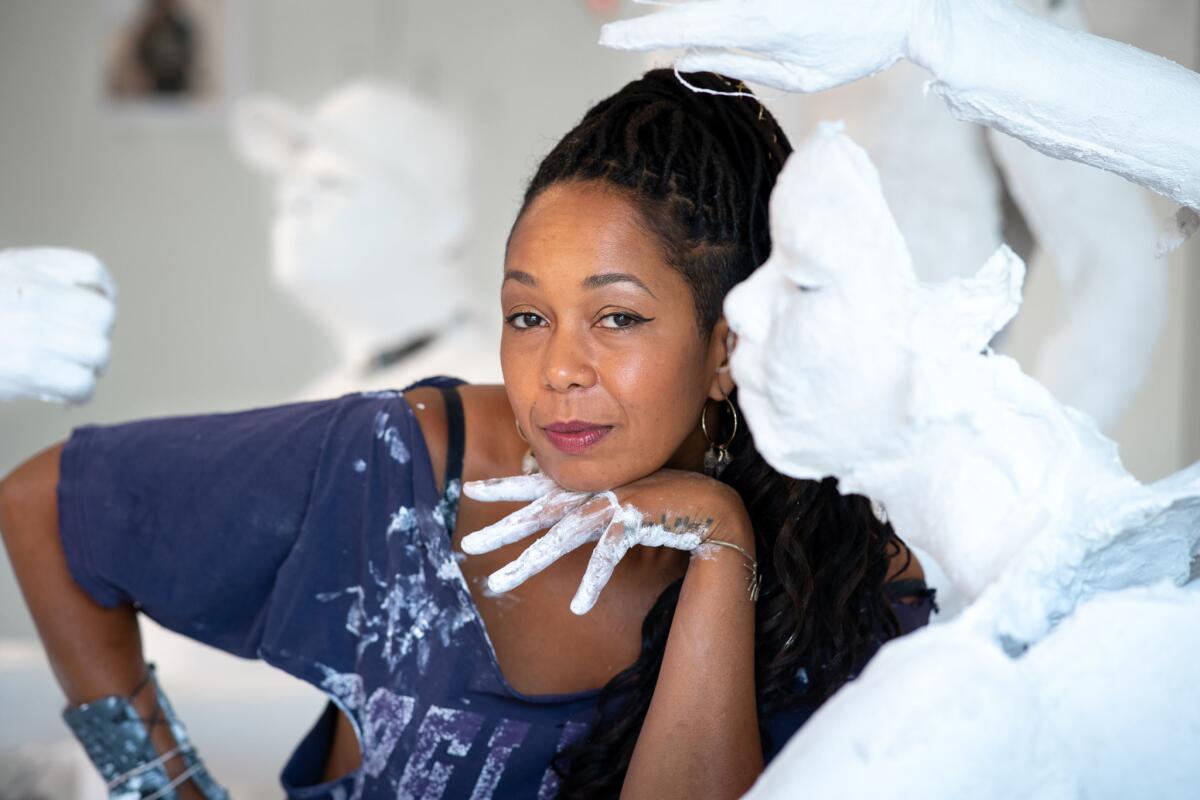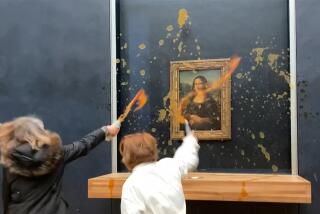Thomas Fire evacuee Karon Davis’ new art crackles with relevance as California copes with more disaster

- Share via
The wildfires blazing through California this month lend tragic resonance to an art exhibition that Karon Davis is preparing in her studio.
The 13 plaster and wire sculptures, Davis’ exhibition opening at Wilding Cran Gallery on Sept. 15, addresses climate change, disasters such as fires and floods, as well as migration and displacement from these events. Karon will turn the gallery into a waterscape, complete with sinking sculptural figures, stormy gray walls and water-damaged wallpaper.
“Muddy Water” is deeply personal for Davis. Last December, as the Thomas Fire cut a path through Ventura and Santa Barbara counties, Davis and her then-7-year-old son were forced to flee their Ojai home late at night in pajamas. They took refuge in L.A. at the Underground Museum, which Davis co-founded with her late husband, Noah Davis. Displaced, mother and son stayed with relatives for months before returning home.
The experience swiftly changed the direction of the work Davis was making, ultimately resulting in her new show, she explains in this edited conversation.
“Muddy Water” means so much here. Can you peel back the layers to help us understand what your exhibition is about?
I hear that word “evacuation” so much right now in the news, it’s part of our daily language. I found this one photo online [of Tropical Storm Noel in 2007] in Haiti, and I started working on a sculpture of a father carrying his son on his shoulders. The water was up to his chin, and he was surrounded by muddy water. It took me on this journey, all these images on the internet of people in floods evacuating in Houston and New Orleans and India.
And most of the images were of brown people. So I started thinking about black bodies being affected by brown water, displaced by brown water, our relationship with water and what’s been going on recently in Compton [where the local agency has delivered dirty water to residents for years]. Muddy waters caused by natural disasters or manmade systems that fail us, whether it’s the levees, the sanitation system or the government that’s supposed to provide clean water to everyone. That is our natural right.
Then I started thinking about the expression “muddy water,” and the times we’re living in, and our president. I often feel I’m trudging through muddy water in this political environment, or in life. As an African American in this country, it definitely feels like we’re constantly trudging through this muddy water of racism, inequality, we’re up to our knees in it.
And muddy water also made me think of Bessie Smith. I’m a huge Blues fan. And her song “Muddy Water,” which was about the great flood of 1927. She sings about mud in her shoes, muddy water in the streets, and she paints this visual and the music just moans and groans.
What was your own evacuation experience like? Was there a single moment when you were faced with that question, “What do I take with me?”
It was a crazy night. My nephews called me outside, and it was a full moon. The moon was red, the whole sky was red. I thought: We have to get out of here. We started hosing down the house. I packed, grabbed my hard drives, my computer, some clothes, mostly personal items from Noah, my son, the cat. My nephews had a dog.
It was a job just to get the paintings out of the house. Imagine 70-mile-per-hour winds and huge canvases. It wasn’t easy. It was smoky and all I could hear was chaos — horses, chickens, dogs, everything was awake and frantic and moving.
Then there was this instant: What are my most precious things I can’t replace? I can replace my clothes, I can replace the bed, but I can’t replace my baby’s paintings and my son. It was just: Get the family and get out.
How did the experience change your work in progress?
Life just changed. For three months I was locked out of my studio. I couldn’t work on what I had planned. I had no choice but put everything on pause. For me, it works best when I’m working from my heart and my spirit, and what I’m going through and what’s moving me at the time, and what’s affecting me. And my hands adapted.
Some of your sculptures are made from the body casts of locals around the Underground Museum. Others are based on photographs or news coverage of natural disasters. What can we expect to see?
I want the gallery to feel as if you’re walking into the flood. So all of the pieces are from the knees up, or the chest up, as if they’re coming out of the floor. As you walk deeper into the gallery, the water gets deeper. The back room will be a rooftop with two kids on top.
There’ll be a boat with a woman and young girl in it, and this old Rastafarian man is leading them out, referencing Noah’s Ark. He’s kind of my Moses character in the water. It looks like an old antiquated scene, but then you see baseball caps and realize it’s a modern scene. I have a young boy, based on the painting “The Blue Boy,” but he’s holding a wet cat. Is the cat dead? Alive? You don’t know. It all looks a little bit like a great flood from the Bible, a scene from Exodus, as they’re trying to get out of the gallery, which is flooded.
The sculptures are these textured, somewhat rough forms with cracked plaster and torn gauze. The wire armatures are occasionally visible. What’s the symbolism?
We’re imperfect beings. Some of us are broken; these characters are people whose hearts are broken. I come from a melancholy place when I’m in the studio, and sometimes I am just a melancholy woman. So it’s a bit of that brokenness coming through. The drips of the plaster are like tears for me.
You can see the steel armatures inside, which are painted, so you can see the strength. Even though it’s breaking apart on the outside, or looks like it is, it’s very strong inside, which I think we all are. Especially when we go through evacuations and floods and anything that challenges us in life. Hardship gives us strength.
Follow me on Twitter: @debvankin
More to Read
The biggest entertainment stories
Get our big stories about Hollywood, film, television, music, arts, culture and more right in your inbox as soon as they publish.
You may occasionally receive promotional content from the Los Angeles Times.











